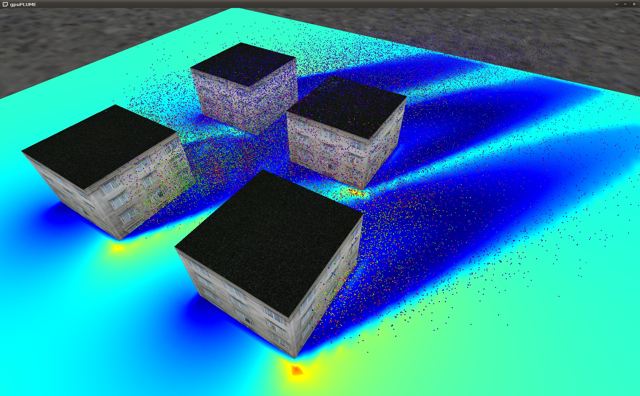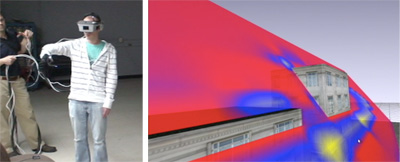Project Overview
Real-time Environmental Simulation
Human populations are increasingly concentrated in urban regions, which, in turn, are becoming major centers of pollution and energy use. Our research aims to give urban planners tools to evaluate the impact of building location and form on pollution dispersal and energy needs.

Our research utilizes GPUs to accelerate dispersion simulation and heat energy transfer to solve problems related to minimizing pollution and energy usage in urban environments.
While prior research enabled single simulations that could predict the impact of a particular design on pollution concentrations, by harnessing the multi-core power of computer graphics hardware (i.e. Graphics Processing Units or GPUs) to quickly run many thousands of simulations, this research is building tools that can suggest best-case designs to urban planners, potentially enabling cities that trap less pollution and require less energy to heat and cool.

We also utilize interactive and immersive virtual environment technology to provide unprecedented understanding and refinement of the complex physical processes associated with the energy balance and pollutant dispersion in an urban setting. We expect that the modeling capabilities that will be developed through this work will aid urban planners in developing useful and novel planning strategies to improve the sustainability of modern cities. Through this tool, we are addressing the following questions aimed at evaluating our hypothesis:
- Can urban form be optimized to minimize air pollution while simultaneously minimizing building energy use?
- Can interactive, immersive visualization and simulation assist engineers, urban planners, and students in understanding and refining complex environmental processes in the urban setting?
Related Publications
- B. Singh, E.R. Pardyjak, A. Norgren, and P. Willemsen. Accelerating Urban Fast Response Lagrangian Dispersion Simulations Using Inexpensive Graphics Processor Parallelism. Environmental Modeling and Software, 26(6), pp. 739–750, June 2011.
- P. Willemsen, A. Norgren, B. Singh, and E.R. Pardyjak. Integrating Particle Dispersion Models into Real-time Virtual Environments. Proceedings of the Eurographics Symposium on Virtual Environments 2008}, p. 57–63, May 2008.
Funding Source
This material is based upon work supported by the National Science Foundation under Grants No. IIS-1162131 and IIS-1162617 (Utah). Any opinions, findings, and conclusions or recommendations expressed in this material are those of the author(s) and do not necessarily reflect the views of the National Science Foundation.
- University of Minnesota Duluth Award: Optimization of Urban Designs for Air Quality and Energy Efficiency. P. Willemsen (PI). Energy and Environment Funds. Spring 2010–June 30, 2011.
- NSF Award: Collaborative Research: Optimization of Urban Designs for Air Quality and Energy Efficiency. Award Number:0828206; Principal Investigator:Peter Willemsen; Co-Principal Investigator:; Organization:University of Minnesota Duluth; CBET Award Date:10/01/2008.
- NSF Award: ITR: (ASE+NHS+ECS)-(int+dmc+sim): Generation of Complex Environmental Flow Patterns for Virtual Environments. Award Number:0428856; Principal Investigator:John Hollerbach; Co-Principal Investigator:Mark Minor, Peter Willemsen, Meredith Metzger, Eric Pardyjak; Organization:University of Utah; Award Date:10/01/2004.
Contributors
- Balwinder Singh, University of Utah, PhD Student
Collaborators
The project is supported by the National Science Foundation and is a highly collaborative project including colleagues from the University of Utah’s Mechanical Engineering Departments and the University of Minnesota Duluth’s Department of Computer Science.